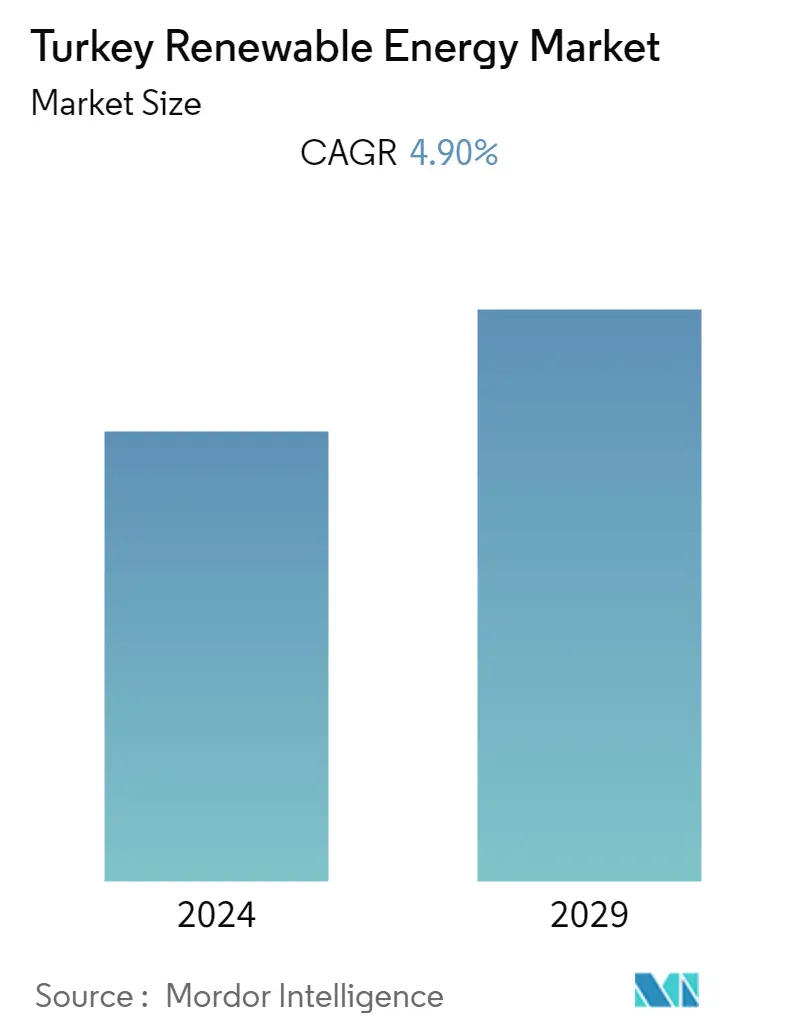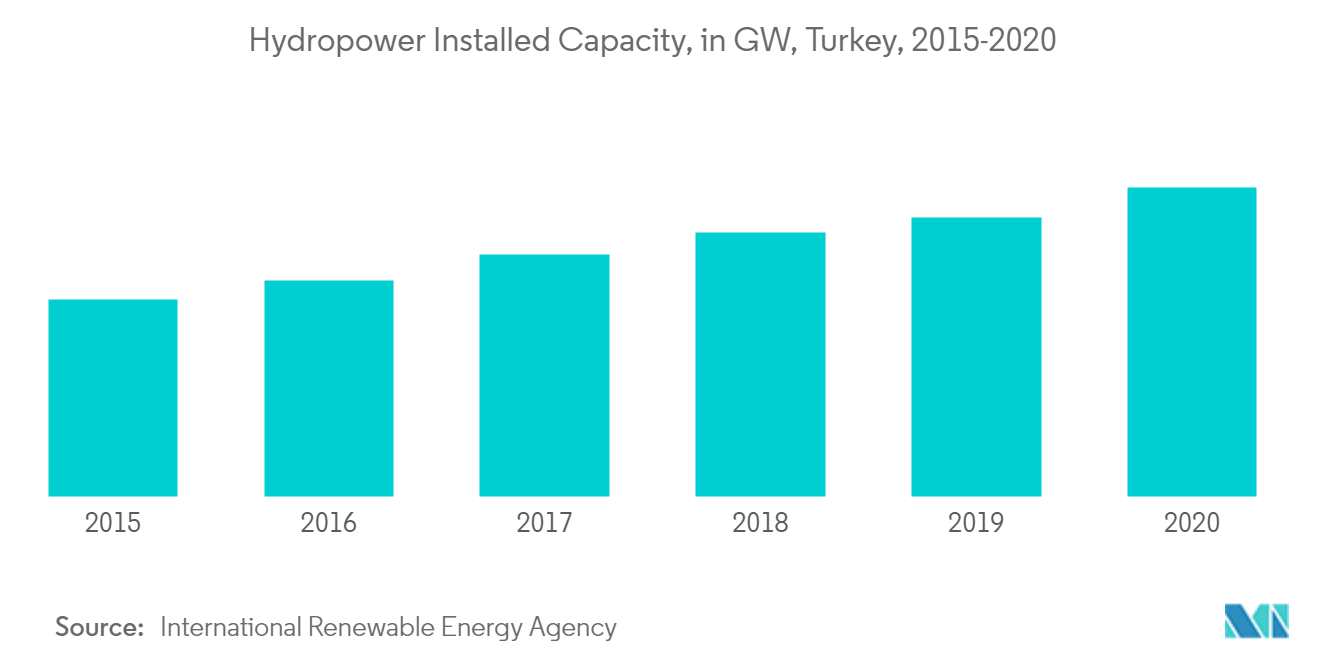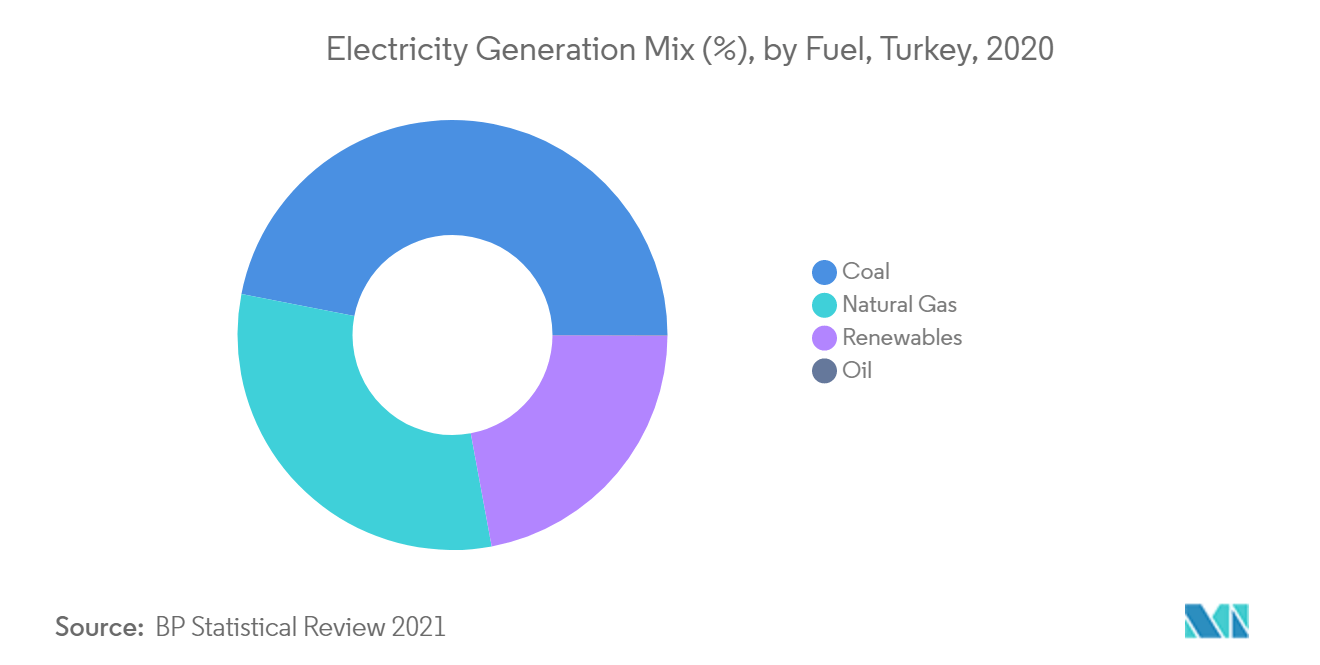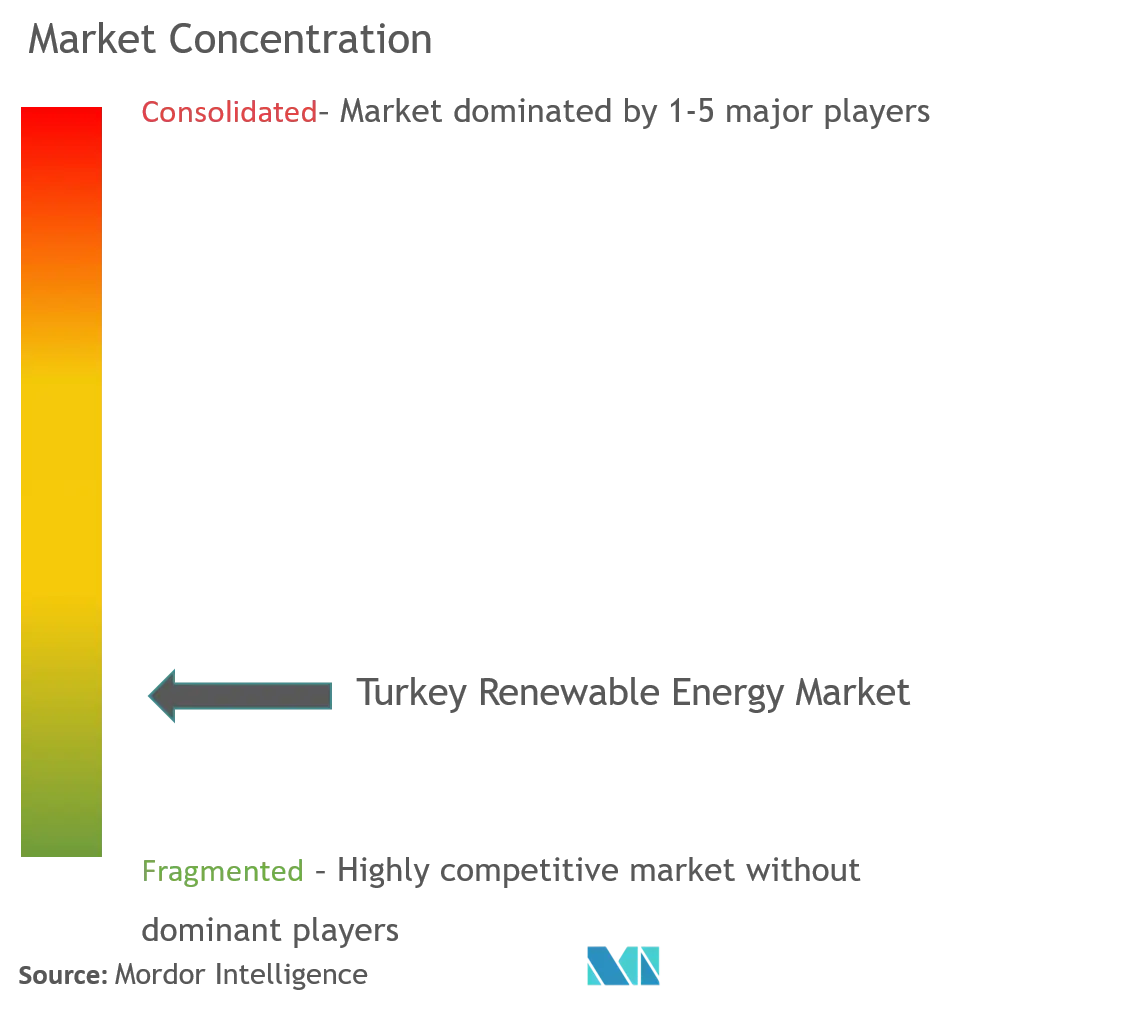Turkey Renewable Energy Market Size

| Study Period | 2020 - 2029 |
| Base Year For Estimation | 2023 |
| Forecast Data Period | 2024 - 2029 |
| Historical Data Period | 2020 - 2022 |
| CAGR | 4.90 % |
| Market Concentration | Medium |
Major Players
*Disclaimer: Major Players sorted in no particular order |
Turkey Renewable Energy Market Analysis
The Turkish Renewable Energy market is expected to register a CAGR of around 4.9% during the forecast period, 2022-2027. The COVID-19 pandemic negatively affected the Turkey renewable energy market by delaying several projects and auctions, including mini renewable energy resource zone (YEKA) auctions for solar photovoltaic systems. The pandemic resulted in the reduced annual additions of solar energy in the country. The primary driver for the market includes the government initiatives to limit its dependence on fossil fuels and use low-cost and sustainable energy sources. However, the lack of proper grid infrastructure to integrate renewable energy sources is expected to hinder the market growth during the forecast period.
- The hydropower segment accounted for a significant market share in 2020, and it is likely to dominate the market during the forecast period.
- In April 2021, the Offshore Wind Energy Association (DÜRED) officials stated that the total offshore wind power potential stood at 75 gigawatts (GW) in Turkey. Such a vast potential of offshore wind energy is expected to create significant opportunities for wind farm operators and developers in the near future.
- The increasing demand for energy and supportive government policies are expected to drive the renewable energy market during the forecast period.
Turkey Renewable Energy Market Trends
This section covers the major market trends shaping the Turkey Renewable Energy Market according to our research experts:
Hydropower to Dominate the Market
- Turkey is a rich country in terms of hydroelectric resources. The current level of installed hydropower capacity is positive. With over 28.5 GW overall (8 GW from river plants and 20.5 GW from reservoir dams), there is still an additional economic potential of up to 50 GW.
- The country is majorly focussing on hydropower-based generation at a considerable pace due to large-scale investments, culminating in the growth in renewable power generation. As of 2020, the country had reached renewable energy installed capacity of 49.398 GW, up from 31.516 GW installed in 2015.
- Moreover, in February 2021, GE Renewable Energy completed the 500 MW Lower Kaleköy Hydropower at the Lower Kaleköy Dam in Turkey. The project is the sixth-largest hydropower plant by installed capacity in Turkey and supplies electricity to one million Turkish households.
- It has more than 25 river basins, including the transboundary Tigris and Euphrates rivers. The country has ambitious plans for hydropower, which is expected to support its target of achieving 100 GW of renewable energy by 2023.
- Thus, due to efforts to increase renewable energy share and reduce dependence on fossil fuels, the hydropower segment is expected to continue its dominance during the forecast period.

Increasing Energy Demand and Supportive Government Policies to Drive the Market
- Energy demand in Turkey has been increasing rapidly for the past few years, leading the government to focus on conventional and renewable energy resources. It is estimated that energy consumption increased at an average rate of around 7.5% every year.
- As of 2020, Turkey was dependent on fossil fuels for electricity generation. However, the country increased its renewable energy share to nearly 22% in its energy mix in 2020 compared to 20.3% in 2019.
- One of the most important causes of the upward change in the renewable energy market in Turkey is reducing its dependence on foreign resources for energy by decreasing energy imports.
- With an increase in energy demand, the government is planning to increase its investment in renewable resources. The country is expected to make an investment of around USD 61 billion by 2023 to mitigate the rising energy demand and expand its existing renewable energy market.
- Moreover, the Turkish government has taken a few initiatives like the National Renewable Energy Action Plan, FiT scheme under Renewable Energy Support Scheme (YEKDEM). The feed-in-tariffs are USD 0.133 for solar and biomass, USD 0.105 for geothermal, USD 0.073 for wind and hydro plants, and it is valid for around ten years.
- Therefore, owing to the above points, supportive government policies and increasing electricity demand in upcoming years is expected to drive the market during the forecast period.

Turkey Renewable Energy Industry Overview
The Turkish renewable energy market is moderately fragmented. Some of the major players operating in the market include IC Ictas Energy Investment Holding, Statkraft AS, Poyry PLC, Sanko Energy Group, and JinkoSolar Holding Co. Ltd.
Turkey Renewable Energy Market Leaders
-
IC Ictas Energy Investment Holding
-
JinkoSolar Holding Co. Ltd.
-
Poyry Plc
-
Statkraft AS
-
Sanko Energy Group
*Disclaimer: Major Players sorted in no particular order

Turkey Renewable Energy Market News
- In July 2021, GE Renewable Energy commissioned the first phase of the Karapinar solar power plant, which has a direct current capacity of 267 MW. The project has an overall installed capacity of 1.08 GW. It is expected to generate 2300 Giga-watt hours (GWh) of electricity annually, enough to meet the power demands of nearly two million Turkish households.
- In January 2021, France-based Albioma acquired a 75% stake in the Turkish geothermal power plant, Gumuskoy. The remaining 25% shareholding interest in the power plant in the Izmir region was acquired by the Turkish industrial services provider, Egesim.
Turkey Renewable Energy Market Report - Table of Contents
1. INTRODUCTION
- 1.1 Scope of the Study
- 1.2 Market Definition
- 1.3 Study Assumptions
2. EXECUTIVE SUMMARY
3. RESEARCH METHODOLOGY
4. MARKET OVERVIEW
- 4.1 Introduction
- 4.2 Turkey Renewable Energy Mix, 2020
- 4.3 Renewable Energy Installed Capacity and Forecast in GW, till 2027
- 4.4 Recent Trends and Developments
- 4.5 Government Policies and Regulations
-
4.6 Market Dynamics
- 4.6.1 Drivers
- 4.6.2 Restraints
- 4.7 Supply Chain Analysis
- 4.8 PESTLE Analysis
5. MARKET SEGMENTATION
-
5.1 Type
- 5.1.1 Hydro
- 5.1.2 Wind
- 5.1.3 Solar
- 5.1.4 Geothermal
- 5.1.5 Other Types
6. COMPETITIVE LANDSCAPE
- 6.1 Mergers and Acquisitions, Joint Ventures, Collaborations, and Agreements
- 6.2 Strategies Adopted by Leading Players
-
6.3 Company Profiles
- 6.3.1 IC Ictas Energy Investment Holding
- 6.3.2 Statkraft AS
- 6.3.3 Poyry PLC
- 6.3.4 Sanko Energy Group
- 6.3.5 Axpo Holding AG
- 6.3.6 JinkoSolar Holding Co. Ltd
- 6.3.7 STEAG Solar Energy Solutions
- 6.3.8 Afyon Geothermal Investments AS
- *List Not Exhaustive
7. MARKET OPPORTUNITIES AND FUTURE TRENDS
** Subject To AvailablityTurkey Renewable Energy Industry Segmentation
The Turkey renewable energy market report includes:
| Type | Hydro |
| Wind | |
| Solar | |
| Geothermal | |
| Other Types |
Turkey Renewable Energy Market Research FAQs
What is the current Turkey Renewable Energy Market size?
The Turkey Renewable Energy Market is projected to register a CAGR of 4.90% during the forecast period (2024-2029)
Who are the key players in Turkey Renewable Energy Market?
IC Ictas Energy Investment Holding, JinkoSolar Holding Co. Ltd., Poyry Plc, Statkraft AS and Sanko Energy Group are the major companies operating in the Turkey Renewable Energy Market.
What years does this Turkey Renewable Energy Market cover?
The report covers the Turkey Renewable Energy Market historical market size for years: 2020, 2021, 2022 and 2023. The report also forecasts the Turkey Renewable Energy Market size for years: 2024, 2025, 2026, 2027, 2028 and 2029.
Turkey Renewable Energy Industry Report
Statistics for the 2024 Turkey Renewable Energy market share, size and revenue growth rate, created by Mordor Intelligence™ Industry Reports. Turkey Renewable Energy analysis includes a market forecast outlook 2029 and historical overview. Get a sample of this industry analysis as a free report PDF download.



